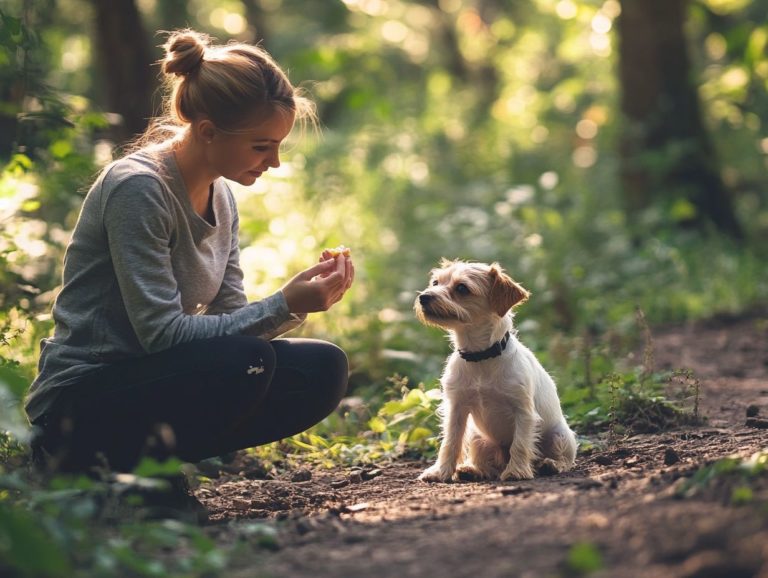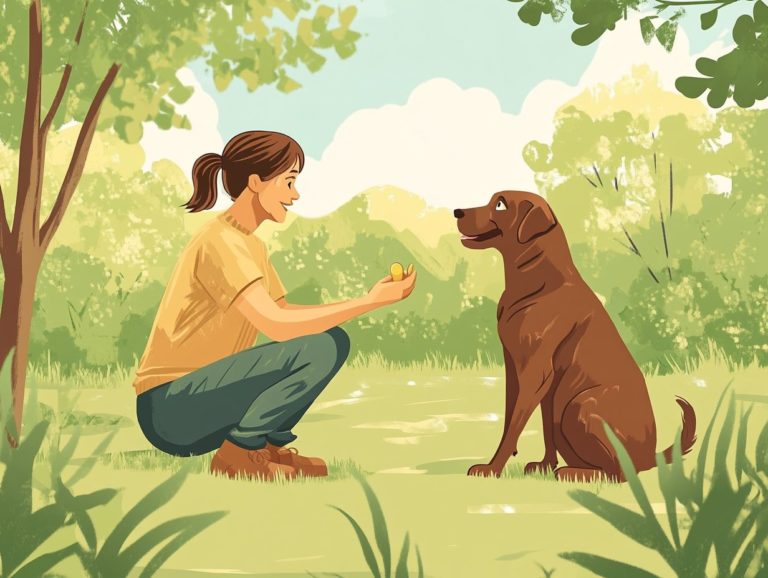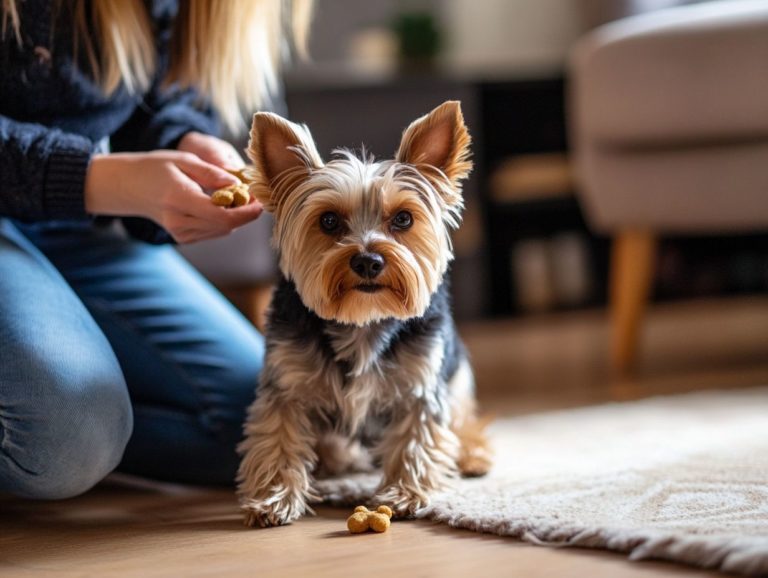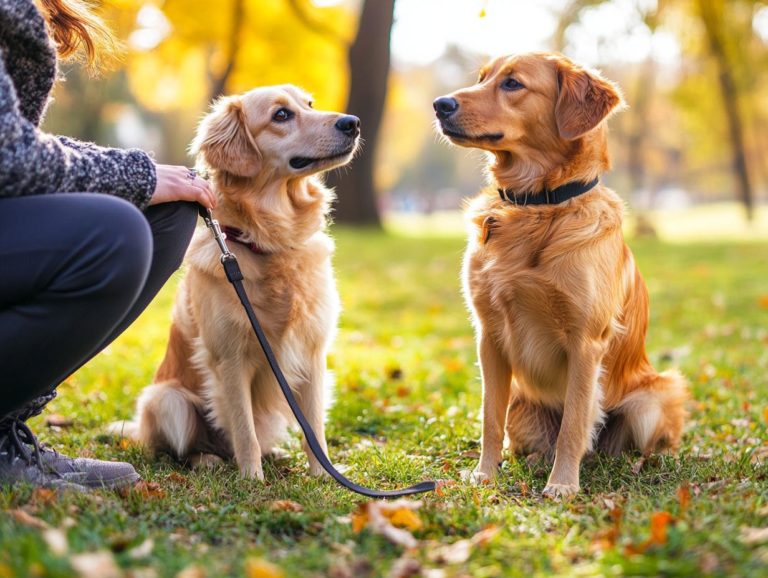Creating a Safe Space: Training Tips for Anxious Pets
Caring for anxious pets is a journey that can be both challenging and rewarding.
Understanding the roots of their anxiety whether from past trauma, environmental factors, or changes in routine is essential.
This guide will empower you to identify the signs that your pet may be struggling. You ll learn to recognize everything from subtle behavioral shifts to more pronounced physical symptoms.
Together, we will explore effective training techniques, like using treats to reward good behavior and helping your pet get used to scary things, while discussing how to cultivate a safe and comforting environment at home.
You ll also find valuable resources available for pet owners seeking support. By the end of this journey, you’ll be equipped with the knowledge to help your furry friend feel more secure and relaxed.
Contents
- Key Takeaways:
- Understanding Anxious Pets
- Signs of Anxiety in Pets
- Training Techniques for Anxious Pets
- Creating a Safe Environment for Anxious Pets
- Additional Resources for Anxious Pet Owners
- Frequently Asked Questions
- What does it mean to create a safe space for an anxious pet?
- Why is it important to have a safe space for an anxious pet?
- How can I create a safe space for my anxious pet?
- Can I use a crate as a safe space for my anxious pet?
- How long should I leave my pet in their safe space?
- Is it okay to use medication to help my pet’s anxiety?
Key Takeaways:
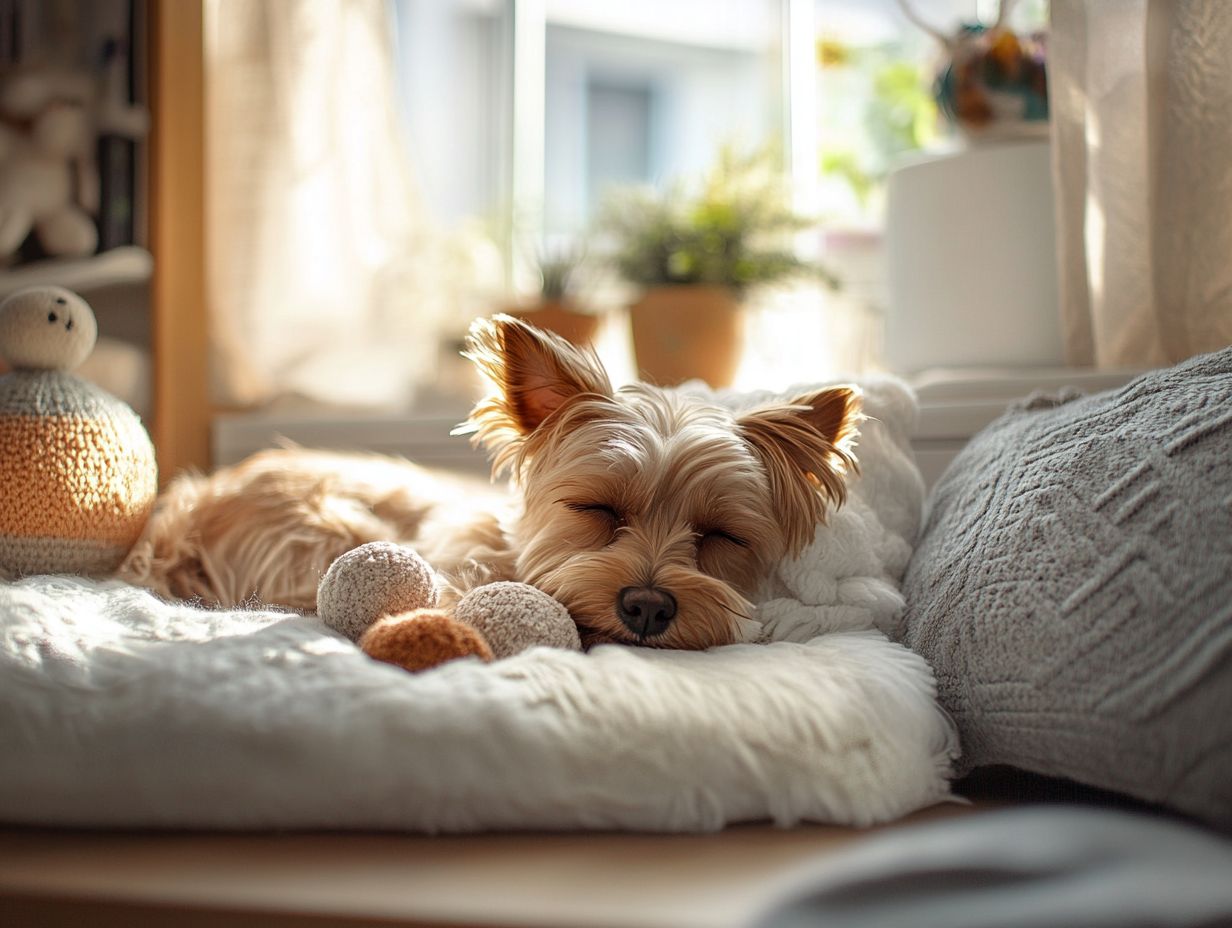
- Anxiety in pets can stem from various factors like past trauma or genetics.
- Watch for behavioral and physical signs to help your pets.
- Training techniques such as positive reinforcement can help anxious pets build confidence.
Understanding Anxious Pets
Understanding anxious pets, especially dogs, is essential for ensuring their emotional and physical well-being.
Many pet owners may not recognize the signs and causes of anxiety in their furry companions, which can result in stress-related behaviors.
By learning to identify when a dog feels uncomfortable or threatened, you can foster a nurturing environment that provides a sense of security and calm. This knowledge becomes particularly crucial for families with children or when welcoming a new puppy into your home, as it helps prevent stress and encourages healthy habits.
Causes of Anxiety in Pets
Various factors contributing to anxiety in pets, particularly dogs, can significantly affect their behavior and overall well-being.
For example, separation anxiety is a common concern; when you leave, your absence can trigger distressing feelings that might lead to destructive behaviors.
Loud noises, like thunderstorms or fireworks, can also incite fear, making it essential for you to be aware of these triggers.
Environmental changes such as relocating to a new home or welcoming a new family member can similarly generate anxiety in your furry friend.
Past traumatic experiences can leave lasting impressions, influencing how a dog reacts to different stimuli. To alleviate these issues, employing training techniques like desensitization and positive reinforcement can be incredibly effective.
It s vital to keep an eye out for safety hazards in your pet s environment to prevent further aggravation of their anxiety.
Signs of Anxiety in Pets
Recognizing the signs of anxiety in dogs is crucial for effectively addressing their emotional needs. These signs can manifest in both behavioral and physical ways, indicating that your pet is feeling overwhelmed or stressed.
For example, you might notice your dog pacing, whining, or engaging in destructive behavior when anxiety sets in. Additionally, physical symptoms such as panting, trembling, or hiding are clear indicators that your furry friend needs a calming environment.
By identifying these signs early, you can cultivate a supportive atmosphere that fosters relaxation and minimizes stress for your beloved companion.
Behavioral and Physical Indicators

Behavioral and physical indicators of anxiety in dogs can vary. They often reveal underlying emotional distress that needs your attention.
You might notice excessive barking, which can be a dog’s cry for help. Destructive chewing typically serves as a coping mechanism as your dog tries to alleviate stress.
Withdrawal behaviors like hiding or refusing to engage suggest that the anxiety has escalated. Your dog feels unsafe or overwhelmed.
Physical symptoms such as drooling or an unusually rapid heart rate can accompany these behaviors. This underscores the connection between your dog’s emotional state and their physiological responses.
Understanding these signs is essential. They often reflect environmental factors like a chaotic home life or changes in routine that can significantly impact your dog’s overall well-being and sense of safety.
Training Techniques for Anxious Pets
Implementing effective training techniques for anxious pets is essential for their emotional comfort and long-term stress management, including knowing how to create a safe space for anxious pets.
By employing positive reinforcement strategies, you can cultivate a stress-free environment for your dog. This helps them feel secure during anxiety-inducing situations.
Techniques like desensitization gradually getting your dog used to something that scares them and changing your dog’s response to a situation prove particularly beneficial when addressing specific fears.
Integrate calming exercises and routines into training sessions. This not only fosters emotional stability but also encourages more relaxed behavior in your pets, ultimately enhancing their well-being across various environments. Understanding the role of trust in training anxious pets can further improve your approach.
Positive Reinforcement and Desensitization
Positive reinforcement and desensitization are two pivotal training techniques for managing anxiety in your dog. They center around creating a secure and nurturing environment.
Focus on rewarding good behavior. This helps your dog learn to stay calm, such as sitting quietly during a lively family gathering.
Gradually exposing your dog to anxiety-inducing situations can significantly bolster their emotional resilience over time. Whether it’s loud noises or unfamiliar visitors, this step-by-step approach allows your dog to acclimate without feeling overwhelmed.
This enables them to build confidence and cope more effectively in the long run.
Creating a Safe Environment for Anxious Pets
Build a cozy retreat for your dog. Creating a safe haven for anxious dogs is essential for nurturing their emotional well-being and comfort, and using techniques to calm anxious pets before training can further enhance this environment.
Designating a specific retreat within your home allows them to escape distressing stimuli. This provides an opportunity to relax and feel secure.
This sanctuary should be thoughtfully equipped with calming elements such as chew toys, soft blankets, and soothing scents. By establishing clear boundaries around this space, you foster a sense of security.
This enables your dog to retreat whenever they feel overwhelmed by stress or anxiety.
Home Modifications and Safe Spaces
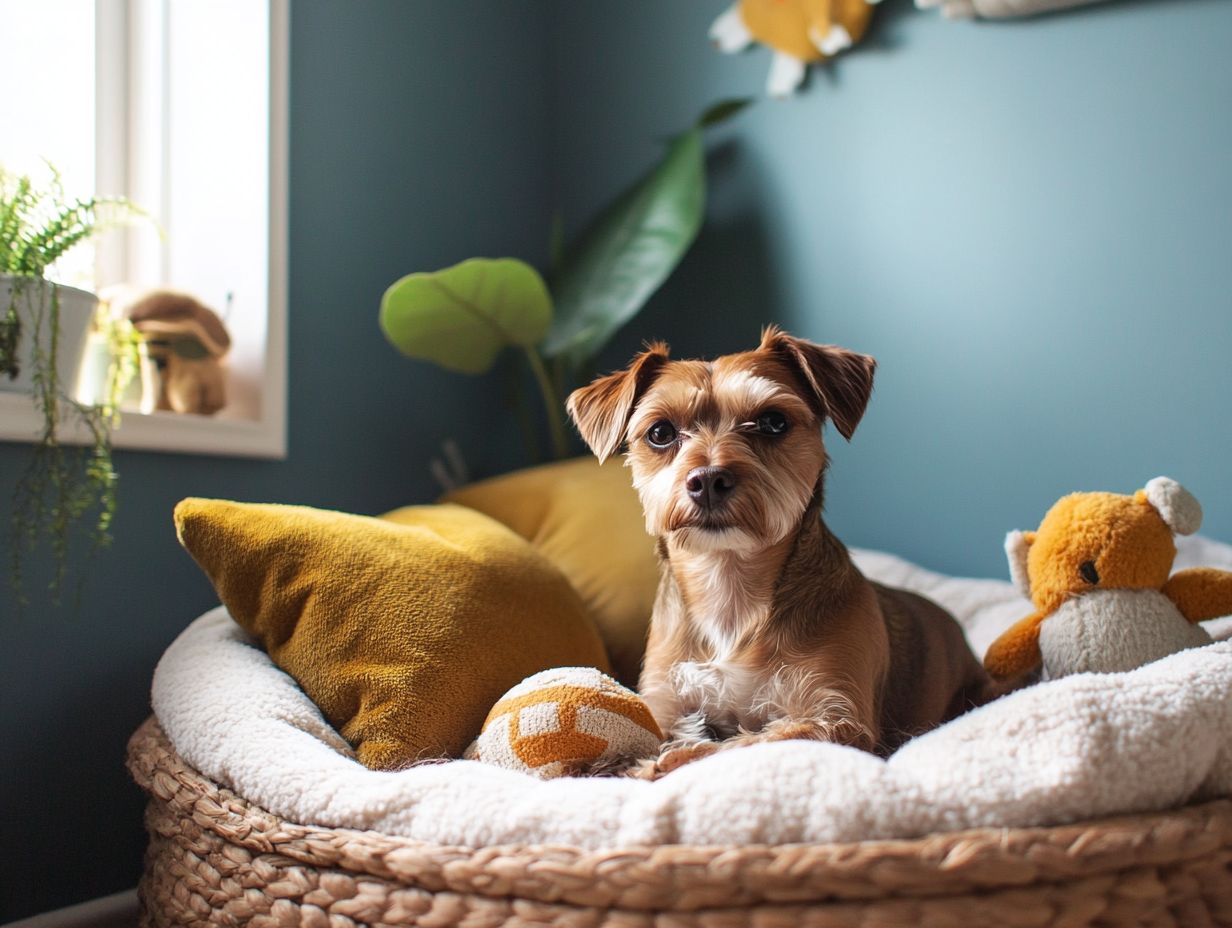
Home modifications that create safe spaces for dogs can profoundly enhance their comfort levels and help your anxious pet feel safe and ease anxiety.
Consider incorporating soundproofing measures, such as adding acoustic panels or hanging heavy curtains. This can effectively diminish noise disturbances that might trigger stress in your furry companions.
Create cozy retreats whether it s a strategically placed crate or a designated corner filled with soft blankets where your dog can retreat and feel secure.
Minimizing safety hazards is also crucial. Ensure that sharp objects are stored out of reach and opt for non-toxic materials to foster a worry-free environment.
Ultimately, by nurturing a consistent and calming atmosphere, you allow anxious pets to feel more at ease. Understanding the science behind training anxious pets promotes their mental well-being and deepens the bond you share.
Start creating a calm space for your dog today!
Additional Resources for Anxious Pet Owners
Resources for anxious pet owners offer essential support in understanding and managing their dog’s anxiety. They include professional guidance from trainers and behaviorists, along with support groups for sharing experiences.
Numerous organizations provide workshops and online sessions designed to educate you about anxiety-related behaviors and effective training techniques. For those looking to tailor their approach, creating a training schedule for anxious pets can also help. Specific products like calming music playlists from Spotify or Pandora can further contribute to a nurturing environment that fosters relaxation for your pet.
Support Groups and Professional Help
Support groups and professional help serve as invaluable resources for dog owners navigating the challenges of anxious pets. These communities provide a safe haven for sharing experiences and emotions, fostering an environment rich in valuable insights.
You may find comfort in knowing you’re not alone in your struggles. Reassurance comes from others who have faced similar issues. The collective wisdom within these support groups often sparks new ideas that you might not have considered.
When paired with the expertise of professional trainers and behaviorists who can craft tailored training plans for your dog’s unique needs this combination can significantly enhance your journey toward a calmer, more confident pet.
Frequently Asked Questions
What does it mean to create a safe space for an anxious pet?
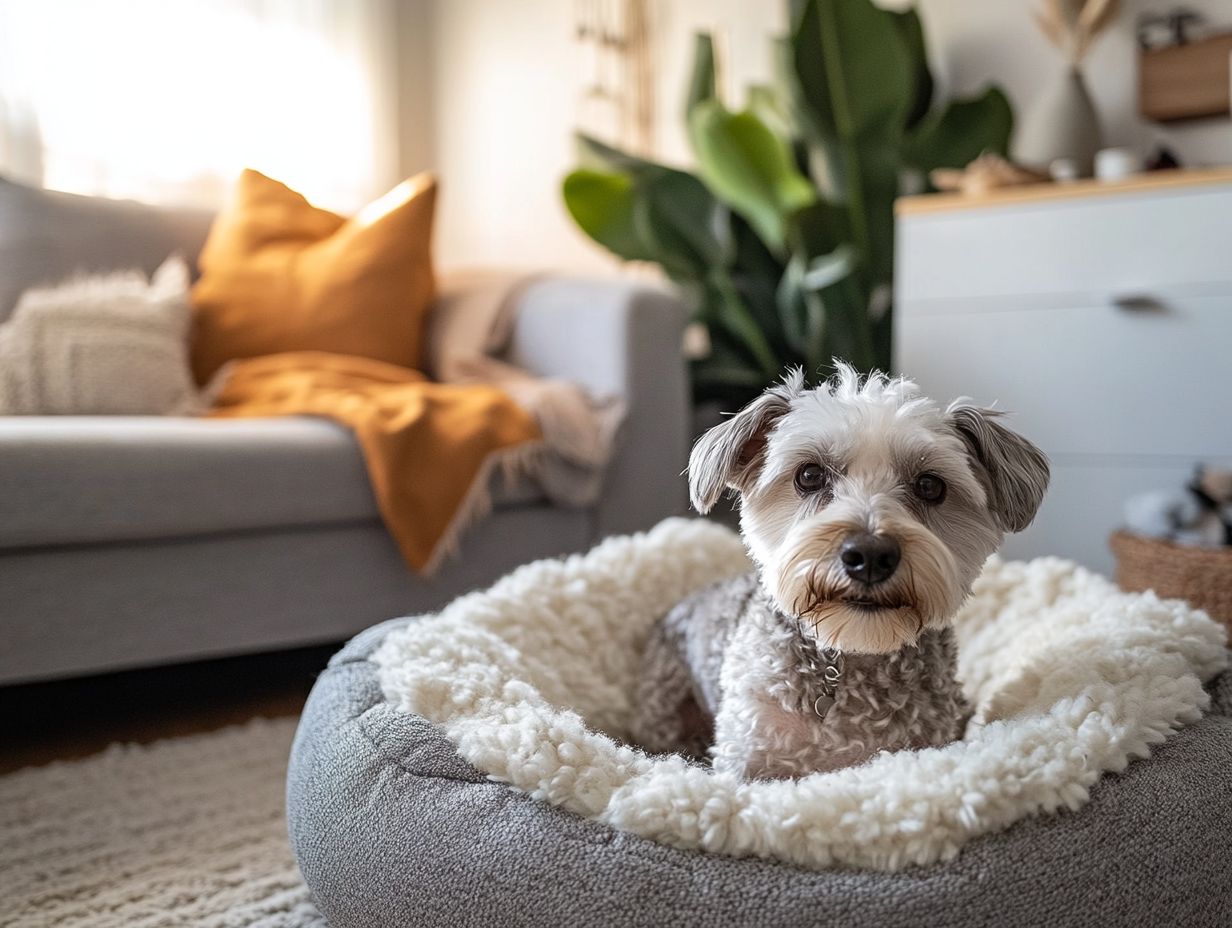
Creating a safe space for an anxious pet means providing a calming and secure environment where they can feel relaxed and at ease. To enhance this process, consider following tips for training anxious pets at home and make this space just for your pet, free from anything that might upset them.
Why is it important to have a safe space for an anxious pet?
Anxious pets can easily become overwhelmed and stressed, leading to behavioral issues and even health problems. Learning how to create a calm environment for anxious pets promotes a sense of security and well-being for your pet by providing a safe space where they can retreat when feeling anxious.
How can I create a safe space for my anxious pet?
The first step in creating a safe space is to identify your pet’s triggers and eliminate them from the designated area. Next, ensure the space is comfortable, quiet, and has items that your pet finds comforting, like their favorite toys or a cozy bed. For additional support, consider how to handle anxious pets during training sessions by using pheromone sprays or calming music to further promote a sense of calmness.
Can I use a crate as a safe space for my anxious pet?
Yes, a crate can be an excellent safe space for an anxious pet, provided they have positive associations with it. Gradually introduce your pet to the crate, and never use it as a form of punishment. The crate should be a safe and comforting place for your pet to retreat to when feeling anxious.
How long should I leave my pet in their safe space?
The amount of time your pet should spend in their safe space varies depending on their individual needs and the severity of their anxiety. It’s essential to monitor your pet’s behavior and gradually increase the time spent in the safe space if they seem to be coping well. However, never leave them in their safe space for extended periods, as they still need social interaction and exercise.
Is it okay to use medication to help my pet’s anxiety?
Medication should always be used as a last resort and under the guidance of a veterinarian. It’s crucial to address the root cause of your pet’s anxiety and use medication as a temporary solution while implementing behavioral training and creating a safe space for your pet. Using medication alone will not address the underlying issue and may not be a long-term solution.


